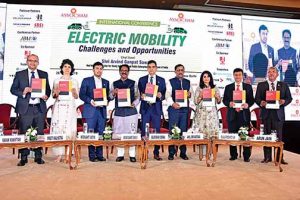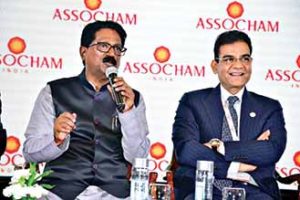Industry-body Assocham conducted an international conference on e-mobility in Delhi.
Story by:
Anwesh Koley
The 6th International Conference on e-mobility conducted by Assocham looked into the challenges faced by the auto sector in India towards successful adoption. Touching upon the need to look at solar energy for powered electric vehicles, the conference drew a large number of auto industry leaders and stakeholders along with government officials. In his opening address, the Union Minister for Heavy Industries and Public Enterprises, Arvind Ganpat Sawant expressed that the government is giving subsidy on electric vehicles because of the high battery costs. He mentioned that there was a need to undertake R&D initiatives in regards to metals and chemicals used in the manufacture of batteries with the view of reducing costs. Stating that his ministry has already put in place the required policy framework in the form of FAME scheme to encourage fast adoption of electric vehicles, Sawant drew attention to the Expression of Interest (EoI) invitation for availing incentives under the said scheme. The FAME II scheme entails the deployment of 5,000 electric buses on operational-cost-model basis across selected cities. So far, three times the stipulated applications have been received, amounting to 15,000 numbers.
Stressing on the positive steps taken by the Heavy Industries ministry, Nishant Arya, Executive Director, JBM Group, said that the (FAME II) initiative would help to build a solid foundation for the industry in the forthcoming years. Aiming at one million two-wheelers and around 0.5 million three-wheelers for ‘greener’ and better last-mile connectivity in one, two and three-tier cities, FAME II is focusing majorly on buses and two-wheelers. It is also encouraging shared mobility in the electric vehicle space. The FAME II scheme is also expected to drive the electric vehicle industry to drive localisation, reduce costs and boost employment. The reduction in GST to five-per cent is also looked upon as a vital development that will boost electric vehicle growth. Stated B K Goneka, President, Assocham, that the government has taken cognizance of e-mobility. “The decision (to reduce GST to five-per cent) is timely and would enhance the potential of the sector,” he averred. Putting in place the required policy framework in the form of the FAME scheme, the Heavy Industries and Public Enterprises ministry is said to be going all out to aid new players to enter the field.
IC engine and EVs
Pointing at the challenges faced by the auto industry, and its dependence on IC engine, union heavy industry minister Sawant mentioned that electric vehicles require less components and less people to manufacture. The rise in such an industry would lead to employees losing their jobs, which is a matter of concern. Touching on the pervasive nature of electric mobility, Preeti Malhotra, Partner & Executive Director, Smart Group, said that electric vehicle technology has become viable and profitable. The need is to get the ecosystem to transition from mobility to e-mobility, she averred. Stating that metro cities like Delhi have become unlivable due to the stratospheric pollution levels, Malhotra explained, “Nations like China, US and countries in the European Union are rapidly adopting electric vehicles, specially in public transportation and in the shared mobility space.” “China is aggressively pushing subsidies on electric vehicles for almost a decade now,” she added. Opining that the Indian Government has constructively pursued its commitment towards converting transportation in India to the electric propulsion medium in a phased manner, Malhotra informed, “Mobility of the future would be electric, shared and autonomous.” Forecast of global growth for electric vehicle fleets is rising exponentially, in India. The move to electric vehicles will be marked by the cost of ownership.
Scope for growth
As volumes pick-up, the costs are expected to halve that of a petrol equivalent, mentioned an industry leader. He added that the cost per kilometre of electric battery aggregators will also drop dramatically. “The economics of electric cars is a treat because of its usage,” he expressed. Stating that electric taxi fleets will lead the change to EVs, Malhotra commented that the mobility revolution is almost here. She drew attention to reports that state the combined annual global ridership of Uber, Ola and other ride hailing operators to be 4.2 billion and growing. “The electric and autonomous segment is almost a USD-two trillion global opportunity and India must aggressively look to adopt it,” she added.
Providing a breakup of how EV adoption will work, Vineet Jain, Principal & Group Head, Automotive Consulting, Nomura Research, mentioned that all industry stakeholders are trying to achieve electrification in a phased manner. By 2030, 80 per cent of the two- and three-wheelers will be electrified. “CVs are expected to have 70 per cent EV adoption, with over 40 per cent buses electrified,” he averred.
Opining that passenger vehicles would achieve 30 per cent electrification by 2030, Jain pointed at the various policy measures like incentives and state EV policies. “The CAFE norms, expected in a few years will also push EV penetration,” he said. Sulajja Firodia Motwani, Founder & CEO, Kinetic Green Energy & Power Solutions Ltd., expressed that she is optimistic about a paradigm shift expected in the Indian auto industry due to electrification. Of the opinion that the industry stakeholders have clarity in the policy circles across verticals, and there is commitment and conviction to take the EV agenda forward, she mentioned, “This was not the case five years ago.” Drawing attention to the clear policy framework the government has put in place, Motwani averred, “Most people earlier thought that electric vehicles will be restricted to passenger vehicles only.” The government has been quick to eliminate any such doubts by providing a clear roadmap for electrification, he added.
Pointing at how the government focused on two-wheelers, three-wheelers and public transport in the first phase of e-mobility adoption, Malhotra stated that around 85 per cent of the Indian population is already availing these modes of transport for their daily commute. The way e-mobility adoption is taking place, it provides enough indication for investors Malhotra quipped. “The middle class has for a long time been reeling under the pressure of high fuel prices,” he added. Electrification, she added, will positively impact the social segment. Kavan Mukhtyar, Partner and Leader, Automotive, PwC India, mentioned that the evolution and adoption of electric vehicles is a complex multi-dimensional problem with many stakeholders involved. “For EVs to be adopted across the country in a sustainable manner, it is not just about regulations, taxation or government incentives, the need is to create significant customer awareness,” he said.
Areas of concern
Opining that everything will fall in place if there is demand, Kavan Mukhtyar said that charging infrastructure is a key factor for the adoption of e-mobility services. Averred Motwani, that there was a need to look into the multi-disciplinary approach to electric mobility. “It is not just the incentives and subsidies, but policies of the transport ministry concerning areas like charging protocol, which will play an important role in EV penetration across the country in the coming years,” she explained. Of the opinion that the local manufacturing push provided by the government gives a clear indication to the industry, Motwani drew attention to the Phased Manufacturing Programme (PMP). Expressing that there is clear direction in doing away with any reliance on Chinese components, Motwani mentioned that the disruption caused is expected to create conflict of interest. “The conflict arises particularly for component manufacturers, who will require to change their existing production process and adopt the upcoming changes,” commented Mukhtyar.
Of the opinion that there was a need to spare a thought for the traditional automotive sector and the socio-economic impact the advent of EVs will create, Mukhtyar mentioned that Indian-owned companies might be the worst affected since many of them still do not have access to global technology. “This will lead to job losses,” he quipped. Stressing on the need to handle the skill gap, which will emerge in terms of servicing and maintenance of e-vehicles, Mukhtyar expressed that the EV industry should keep an eye on quality. Touching on the need to maintain product quality without causing a heavy dent on customers’ pocket, Jain said, “The CV space can largely be regulated, but PV electrification depends largely on consumer needs and their cost requirements.” “Manufacturing, supply chain and charging infrastructure are the key enablers apart from battery manufacturing and battery recycling,” he reasoned. Stating that the EV supply chain in India is at a nascent stage, Jain drew attention to the government’s intention to increase the custom duty in a phased manner to encourage local production of critical components beyond 2021. “Subsidies will be applicable only if the manufacturer is able to localise production of critical components,” Jain quipped.
Calling upon the need to strike synergies with sector like power and telecom with the battery at the core, Jain expressed that attention should be given to local manufacture of cells, which is currently a distant dream. The right technology is necessary to harness the potential, he added. Claiming that majority of Indian suppliers are capable of producing motors up to 33 kW, Jain said, “The challenge lies in higher capacity motor production.” “To address this, it is expected to take some time due to the high costs involved,” he averred. Said Mukhtyar, “Start ups and newer entrants in the market will have an important role to play in EV penetration and adoption.” “Large scale OEMs have an ROI-based approach towards all activities and their risk appetite is not as high as it is for the startups,” he expressed. Stressing on the need for a vibrant startup ecosystem, Mukhtyar said, “Funding will play a crucial role in the success of EVs in India.” Stating that there is business viability for commercial fleets that are using a vehicle for more than 150 kms, he explained that there is a good scope to lower the operating costs of such vehicles in electric mode. “Shared mobility is just the right platform for adoption of public transport,” Mukhtyar said.
The way forward
Finding a common ground on the need to promote electro-mobility to tackle congestion and pollution, those present at the conclave delved upon the disruption that could be coming the way of the auto industry. Malhotra expressed that new technology disrupts the existing ecosystem and creates a conflict of interest. It must be presented carefully and in an innovative way. Pointing at reports, which indicate that the government has asked Ola, Uber and other taxi aggregators to have at least 40 per cent of their fleet running on electricity by 2026, Malhotra mentioned, “At least five-per cent of the ride hailing fleets can be mandated to go electric by 2020 to start with.” Averred Motwani, “Resistance to change will always be there. The onus on the implementation of a new technology is on the government, and it should take strict decisions.” Calling upon the fleet owners to also support the government to create an ecosystem where demand drives supply, Motwani said, “Besides FAME II, the government can enable faster adoption of EVs in various ways.”
Stressing on the need for government support, and for setting up an efficient charging infrastructure, Malhotra stated that commercial EV rides must be completely exempted from GST in the initial phases. Even the GST on the charging facility should be waved off, she said. Emphasising on insurance companies offering attractive insurance schemes for EV owners with lower premiums and the availability of free parking spaces, Malhotra averred, “To encourage the proliferation of EVs, banks should also provide preferential financing options at lower interest rates.” Of the opinion that the EV industry will need the right financial instruments to ensure smooth operations, and to attract new players, Nishant Arya said, “The government could provide incentives for domestic and international companies to set up local R&D facilities and other allied infrastructural requirements.” “Companies are coming together to understand and implement e-mobility concepts through a better understanding of government policies and guidelines,” he concluded.

























